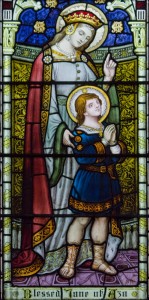Bl. Juana de Aza, Mother of St. Dominic
 Today is the memorial of Bl.Juana, mother of St. Dominic. We have a delightful statue in the novitiate of Bl. Juana with St. Dominic and his brother Bl. Mannes which we hope to share with you later.
Bl. Juana and her husband, Felix, are celebrated as blesseds in the region of St. Dominic's birthplace, Caleruega. To this day you can see Bl. Juana's wine cellars!
Today is the memorial of Bl.Juana, mother of St. Dominic. We have a delightful statue in the novitiate of Bl. Juana with St. Dominic and his brother Bl. Mannes which we hope to share with you later.
Bl. Juana and her husband, Felix, are celebrated as blesseds in the region of St. Dominic's birthplace, Caleruega. To this day you can see Bl. Juana's wine cellars!
In honor of Bl. Juana we want to share with you the annual Pilgrimage of the people of St. Dominic's village of Caleruega to nearby Castro. This very old pilgrimage was thought to have been done by St. Dominic's family as well. Below is an excerpt of what the pilgrimage is all about. Please forgive our poor translating abilities.
The video is highlights of the pilgrimage. It is all in Spanish but even if you don't understand Spanish you can get a sense of the faith of the people of Caleruega and their love for St. Dominic and our Lady. The pilgrimage ends at the Dominican Monastery built on the place of the Guzman castle and you can see the nuns in the back behind the grille.
Pilgrimage of Castro
Every year on the third Sunday in April (if it matches the fourth Sunday of Easter) is celebrated in Caleruega the pilgrimage to the shrine of the Virgin de Castro, located in the Alto de Castro called on the Roman ruins of Clunia , Peñalba de Castro.
This is one of the most deeply rooted traditions in the town, so much so that every year the influx of "pilgrims" is larger. Is this the only day on which the whole town gathers in the same place to spend the day, both those living in the village and those outside, and every year they return to Castro in search of their roots.
The Pilgrimage step by step The procession begins at 9 am, but several hours before the church bells chime. It is here where they have the candlesticks, the cross, the script and the statue of Saint Dominic: “El Santito”. “El Santito” is certainly the figure of the day. This statue of Saint Dominic, from the seventeenth century, only goes out on this day, usually it remains at the Royal Monastery of the Dominican Nuns. This “El Santito” is place on a light sedia to carry it more comfortably, to which has been added as a canopy an awning to keep out the rain, which at times has been heavy. The newlyweds of this year carry the statue to the various churches we visit simply to keep order, since there are many who want to carry “El Santito”.
The first stop on the road is out of town, opposite the cemetery. Here a dirge is sung. Next stop, one of the most special, is done at the "Stone of Castro." This is where the mayor proclaims a speech to all villagers and visitors who are with us on this day.
It starts from "the Stone" to the village of Torre Arauzo. Most people will walk. Only a few adults, and especially children go in cars, which takes the food
The arrival at Arauzo Tower, which is 9 kilometers from Caleruega roughly occurs at 10 am in the morning. Before entering the village is the the chapel of the Virgen de los Remedios, to which the pilgrims briefly pray. A typical lunch of brandy, muscat and biscuits is eaten before continuing the journey. Once within the precincts of the ruins of Clunia , women from Peñalba de Castro receive “el Santito” and lead to the shrine of Our Lady of Castro on a path located above what was probably the Roman city of Clunia Sulpicia .
After the Mass dedicated to Our Lady of Castro and Santo Domingo, lunch is eaten in the courtyard like a picnic, is found a typical sweet of the day fried milk!
At 5 pm in the same chapel we pray the Rosary and singing farewell to the Virgin. From here, the path splits again in procession to Arauzo Tower.
Before reaching Tower, we begin praying the Rosary going to the Church of San Pedro Regalado in Torre. In the Church prayers are said for the dead, and then all the pilgrims eat a snack, enjoying the company of families and people we have befriended.
At 8 PM we go to the hermitage of the Virgen de los Remedios, and when we get to the paved road we sing the Salve to the Virgin. Then out on the street we say good bye and begin the road back home. We process toward the Monastery of the Dominican Nuns and gather in their church to sing the Salve and the hymn to Saint Dominic and then good bye until next year.
This is undoubtedly the most beautiful tradition of our people. We make the pilgrimage in order to ask for something special of St. Dominc or to give thanks for a favor. The devotion that people have towards Saint Dominic is much more evident here than on the 8th of August.
The origin of the tradition of this pilgrimage is unknown. What has been passed down to our day is that Saint Dominic, with his family, went to this place to pray to the Virgen de Castro because of the great devotion they had to the Virgin.